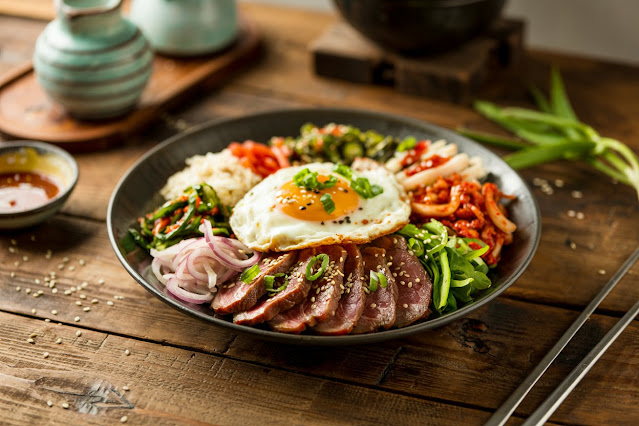When it comes to international cuisine that has captured the global food scene, Korean BBQ stands out for its bold flavors, interactive dining experience, and cultural richness. But in our fast-paced world, it’s not always easy to gather around a grill with a spread of marinated meats and side dishes. Enter the Korean BBQ Bowl — a modern, convenient twist on a classic Korean dining tradition.
What Is a Korean BBQ Bowl?
A Korean BBQ Bowl is a simplified and portable version of traditional Korean BBQ (or gogi-gui, meaning "meat roast"). Rather than grilling at the table, the meat is pre-cooked and layered over rice with a mix of Korean side dishes (called banchan), vegetables, and sauces. These bowls retain all the rich flavors of a full Korean BBQ meal but in a single, easy-to-eat dish.
Components of a Korean BBQ Bowl
A well-crafted Korean BBQ bowl typically includes:
-
Grilled Protein
The centerpiece of any Korean BBQ bowl is the meat. Popular choices include:-
Bulgogi: Thinly sliced marinated beef with a sweet and savory flavor.
-
Dak Galbi: Spicy grilled chicken.
-
Samgyeopsal: Grilled pork belly, often caramelized to perfection.
-
Tofu or Mushrooms: A great vegetarian or vegan alternative.
-
-
Steamed Rice or Grains
White rice is the traditional base, but health-conscious variations may use brown rice, cauliflower rice, or quinoa. -
Fresh and Pickled Vegetables
A colorful mix of raw and pickled veggies adds texture and tanginess:-
Kimchi (fermented cabbage or radish)
-
Pickled cucumbers
-
Julienned carrots
-
Shredded lettuce
-
Bean sprouts (sukju namul)
-
Sautéed spinach (sigeumchi namul)
-
-
Sauces and Garnishes
-
Gochujang: A fermented red chili paste, spicy and slightly sweet.
-
Sesame oil: Adds a nutty aroma.
-
Soy garlic glaze, scallions, toasted sesame seeds, or a fried egg can top off the dish.
-
The Origin of Korean BBQ and Its Evolution
Korean BBQ dates back to the Goguryeo era (around 37 B.C. to 668 A.D.), with records of marinated and grilled meats served during royal feasts. Over centuries, Korean BBQ evolved into a cultural experience, emphasizing communal dining, grilling meats tableside, and sharing numerous side dishes.
With the rise of fast-casual dining and food delivery apps, Korean cuisine adapted to modern lifestyles. The Korean BBQ bowl emerged as a flavorful, convenient meal that maintains authenticity without requiring a table grill or long preparation time.
Why Korean BBQ Bowls Are So Popular
-
Health-Conscious Appeal
Despite their rich flavors, Korean BBQ bowls can be incredibly nutritious. Lean proteins, fermented vegetables, and low-oil cooking methods make them a balanced choice for health-conscious eaters. -
Customizable and Versatile
These bowls are easily customizable. From spicy gochujang lovers to keto dieters swapping out rice for greens, everyone can personalize their bowl. -
Meal Prep Friendly
Korean BBQ bowls are ideal for meal prep. Marinated meats can be cooked in batches, vegetables can be pickled or roasted in advance, and bowls can be assembled fresh each day. -
Bursting With Flavor
Thanks to Korean marinades that often blend soy sauce, garlic, ginger, pear juice, and sesame oil, the flavor profile is bold, complex, and satisfying.
How to Make a Korean BBQ Bowl at Home
Here’s a basic recipe to get you started:
Ingredients (2 servings)
For the beef bulgogi:
-
1/2 pound thinly sliced beef (ribeye or sirloin)
-
2 tbsp soy sauce
-
1 tbsp sesame oil
-
1 tbsp sugar or honey
-
1 tbsp grated Asian pear (optional)
-
2 garlic cloves, minced
-
1/2 tsp grated ginger
-
1 tsp rice vinegar
-
1 tsp gochujang (adjust to taste)
-
Sesame seeds and chopped green onions for garnish
Bowl Components:
-
2 cups steamed rice
-
1/2 cup kimchi
-
1/2 cup sautéed spinach with garlic and sesame oil
-
1/2 cup bean sprouts (blanched and seasoned)
-
1/2 cup shredded carrots (raw or lightly sautéed)
-
1 fried egg (optional)
-
Gochujang or soy garlic sauce for drizzling
Instructions:
-
Marinate the Beef:
Mix all marinade ingredients and combine with sliced beef. Let it sit for at least 30 minutes, or overnight for best flavor. -
Cook the Beef:
Heat a grill pan or skillet over medium-high heat. Cook beef slices until browned and slightly caramelized, about 4–5 minutes. -
Prepare Veggies:
While the beef marinates or cooks, prepare the vegetables. You can sauté spinach with a bit of garlic and sesame oil, and lightly sauté or blanch other vegetables. -
Assemble the Bowl:
Start with a base of rice, then layer on vegetables, beef, and a fried egg if using. Drizzle gochujang sauce or soy garlic glaze on top. Sprinkle with sesame seeds and chopped green onions. -
Serve and Enjoy!
Where to Find Korean BBQ Bowls
These bowls are now a common menu item at Korean restaurants, Asian fusion cafés, and food trucks worldwide. They’re especially popular in urban areas where quick, healthy meals are in demand.
Several meal delivery services and frozen meal brands have also introduced Korean BBQ-inspired bowls, making them accessible even for those unfamiliar with Korean cooking techniques.
Cultural Influence and Fusion
Korean BBQ bowls are part of the wider wave of Korean culture (known as the Hallyu Wave) sweeping the globe. From K-pop and K-dramas to Korean skincare and cuisine, global curiosity about Korean culture is at an all-time high.
The fusion of traditional flavors with Western meal formats — like bowls and wraps — has introduced Korean cuisine to broader audiences. You might find Korean BBQ burritos, tacos, sliders, or even pizzas that fuse the classic marinade with international formats.
Final Thoughts
Korean BBQ bowls are more than just a food trend — they represent a cultural bridge between tradition and modern convenience. Whether you're enjoying a homemade version or picking one up on your lunch break, these bowls deliver everything from bold flavors and balanced nutrition to the comforting satisfaction of a home-cooked meal.











0 Comments